masterwritingatwork
Proofread.com

204 pages, 42 lessons, 198 exercises
Available soon in paperback.
Punctuation
Comma - Use the comma to introduce, connect, or separate.
Apostrophe - Learn the best way to always get its/it's correct.
Colon - Use the colon properly: to point to things.
Hyphen - Know when and how to use the hyphen properly.
Interrupt - Know which marks to use when interrupting the reading.
Quote - Use quotes for special emphasis or to show words spoken.
Grammar
Match Verbs - Use basic techniques to fix verb agreement.
Match Pronouns - Make pronoun references correct and clear.
Match Modifiers - Change dangling and misplaced modifiers.
Pronoun Case - Recognize and fix problems with pronoun case.
Who Whom - Try the technique to always get who/whom correct.
Subjunctive - Use proper verb forms for wishing and wanting.
Usage
Capitalize - Learn the tricky rules for when to capitalize.
Numbers - Know the rules for spelling out numbers.
Further Amount - Be smart and use the right word.
Imply Awhile - Be smart and use the right word.
Homonyms - Try memory aids for similar-sounding words.
Idiom - Practice with the accepted ways of saying things.
Clarity
Redundancy - Remove redundant words from common phrases.
Verbosity - Edit out words that contribute nothing to a sentence.
Pomposity - Recognize and replace bloated words and phrases.
Active Voice - How to change sentences to active voice.
Alignment - Align grammar with story in each sentence.
Action Edits - How to bring out the action in your sentences.
Style
Drivel - Recognize and edit cliches and mumbo jumbo.
Negatives - How to keep them clear for your reader.
Parallels - Use parallel construction to improve readability.
Variety - Learn ways to avoid writing boring sentences.
Guidance - Use transitions and links to guide the reader.
Presentation - Loosen, layer, and list to make the reading easy.
Influence
Style and Tone - Adjust your style to achieve the proper tone.
Reader Focus - Talk with your reader and about your reader.
Compelling Edits - Change your words to truly engage your readers.
Custom Wording - Improve reader reaction by speaking their language.
Trusted Acceptance - Understand decision shortcuts used by your reader.
Effective Tactics - Subtle wording choices to influence your reader.
Send or Not - Know when not to send an email.
Request Etiquette - How to write effective requests.
Response Etiquette - Good habits for a productive workplace.
Being Assertive - Respond professionally to contentious emails.
Being Conciliatory - How to prevent misreading by upset recipients.
First and Last - Good habits for effective communications.
masterwritingatwork
Proofread.com